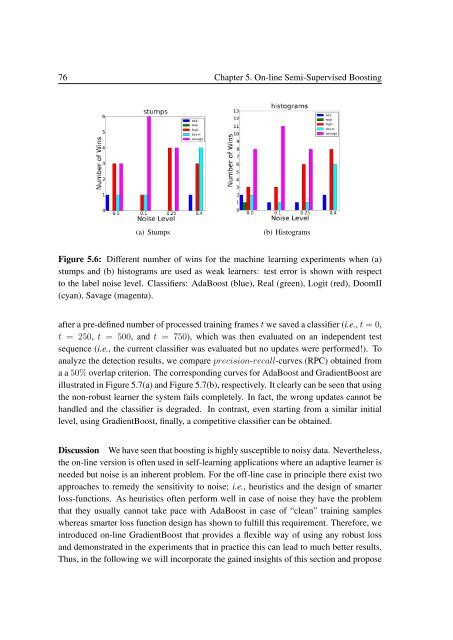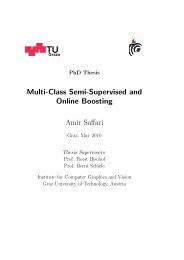PhD Thesis Semi-Supervised Ensemble Methods for Computer Vision
PhD Thesis Semi-Supervised Ensemble Methods for Computer Vision
PhD Thesis Semi-Supervised Ensemble Methods for Computer Vision
Create successful ePaper yourself
Turn your PDF publications into a flip-book with our unique Google optimized e-Paper software.
76 Chapter 5. On-line <strong>Semi</strong>-<strong>Supervised</strong> Boosting<br />
(a) Stumps<br />
(b) Histograms<br />
Figure 5.6: Different number of wins <strong>for</strong> the machine learning experiments when (a)<br />
stumps and (b) histograms are used as weak learners: test error is shown with respect<br />
to the label noise level. Classifiers: AdaBoost (blue), Real (green), Logit (red), DoomII<br />
(cyan), Savage (magenta).<br />
after a pre-defined number of processed training frames t we saved a classifier (i.e., t = 0,<br />
t = 250, t = 500, and t = 750), which was then evaluated on an independent test<br />
sequence (i.e., the current classifier was evaluated but no updates were per<strong>for</strong>med!). To<br />
analyze the detection results, we compare precision-recall-curves (RPC) obtained from<br />
a a 50% overlap criterion. The corresponding curves <strong>for</strong> AdaBoost and GradientBoost are<br />
illustrated in Figure 5.7(a) and Figure 5.7(b), respectively. It clearly can be seen that using<br />
the non-robust learner the system fails completely. In fact, the wrong updates cannot be<br />
handled and the classifier is degraded. In contrast, even starting from a similar initial<br />
level, using GradientBoost, finally, a competitive classifier can be obtained.<br />
Discussion We have seen that boosting is highly susceptible to noisy data. Nevertheless,<br />
the on-line version is often used in self-learning applications where an adaptive learner is<br />
needed but noise is an inherent problem. For the off-line case in principle there exist two<br />
approaches to remedy the sensitivity to noise; i.e., heuristics and the design of smarter<br />
loss-functions. As heuristics often per<strong>for</strong>m well in case of noise they have the problem<br />
that they usually cannot take pace with AdaBoost in case of “clean” training samples<br />
whereas smarter loss function design has shown to fulfill this requirement. There<strong>for</strong>e, we<br />
introduced on-line GradientBoost that provides a flexible way of using any robust loss<br />
and demonstrated in the experiments that in practice this can lead to much better results.<br />
Thus, in the following we will incorporate the gained insights of this section and propose



